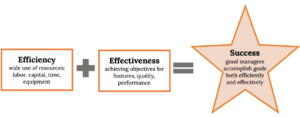7.6 What is Successful Management?
Adapted by Stephen Skripak with Ron Poff
With this renewed understanding of leadership, let us now return to the scenario that we started with at the beginning of this chapter; your expanding note-taking business. Your business has started with some degree of success. You have generated a large number of orders based on a successful social media campaign. However, this sudden ramp up in demand reveals that your organization is not yet sufficiently set up to deliver on all of these requests. You quickly find that you are unable to meet deadlines, you are losing some customers because you are taking too long to respond to them, and customers are unhappy.
Despite your fantastic leadership and vision, your organization lacks effective management. Your processes are not very efficient, and they are not designed to effectively provide the services you are advertising. You decide you will need to either upskill your management abilities, or lean on the abilities of someone else who can provide a management focus.

Management is, at its core, the ability to combine the two elements of efficiency and effectiveness, in order to see a goal succeed. Both leadership and management are necessary in order for a goal or organization to succeed. We have already said that management without leadership is aimless: is no use being efficient and effective if the goal you are aiming for the wrong goal. It is equally true that leadership needs management to achieve its aims.
Visionary leaders like Martin Luther King and Harvey Milk are often given much credit for the pioneering changes they make from a public platform, and it is right that we recognize their tenacity and unique gifts. However, in every successful movement there is an organized and highly-managed set of tasks being accomplished at the ground level. For example, during the Montgomery bus boycott, black churches organized collections of shoes to be donated to people who had to walk to work each day. Conversely, the lack of a good campaign manager hindered Harvey Milk’s first attempt to run for public office (he subsequently became the first openly gay may to be elected to public office in California).
There are times when the functions of both leadership and management are fulfilled by the same person. This tends to be true in smaller organizations, like small businesses or nonprofits. The owner of a local restaurant may decide that the restaurant will be the best venue for seafood in the local area (leadership). She may also be the person who negotiates prices with local wholesalers (management).
Often, the roles of leadership and management are held by different people – think of a C-suite, where a CEO will ideally lead the whole company, while the CFO manages finances, and the CTO manages technology.
Sometimes these roles are even distributed across a team. An example of this is the software development framework Scrum. In this methodology there is no ‘leader’ or ‘manager’ in the traditional sense: In a Scrum team a product owner sets the vision for the project (leadership) and manages the backlog but does not manage people or deadlines; a Scrum master on the team ensures that Scrum processes are being followed and removes roadblocks, but also does not assign tasks or set deadlines. The development team are responsible for setting their own deadlines, and natural technical leaders may emerge in different areas, but there is not a formal hierarchy in the traditional sense. Even though the functions of leadership and management are not formally bound to job titles in the Scrum framework, they are both present.
Key Takeaways
- Projects and organizations need both leadership AND management in order to succeed.
- Management must include both efficiency (accomplishing goals using the fewest resources possible) and effectiveness (accomplishing goals as accurately as possible).

